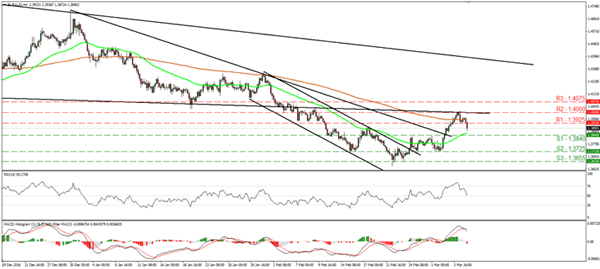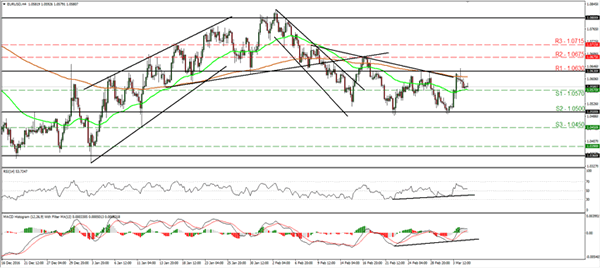Overnight, the Reserve Bank of Australia kept its borrowing costs unchanged and maintained its neutral bias with regards to policy. The meeting statement was more or less a repetition of the previous one, offering little fresh information to investors. The Bank reiterated that the domestic economy remains robust, and for the umpteenth time it noted that it prefers a weaker currency, as an appreciating Aussie could complicate economic adjustments. Perhaps the most noteworthy point was that the officials are still worried about high housing prices posing a risk to financial stability. This suggests that the bar for any further easing remains high, reinforcing our view that the Bank is likely to stay on hold for a while. Perhaps due to the lack of fresh forward guidance from the RBA, the reaction in the Aussie was relatively limited on the decision, though the currency moved a bit higher against its major counterparts in the following minutes.
Looking ahead, the outlook for the Aussie appears cautiously positive in our view, at least against most of its major counterparts. The RBA has shown little appetite for further easing, and has maintained a neutral stance in all its latest communications. At the same time, Governor Lowe recently indicated that it’s hard to say that the Australian dollar is overvalued, implying that the RBA may be tolerant of some further gains in the currency. What’s more, iron ore prices have surged in recent months, something likely to continue to support Australia’s commodity-exporting economy. However, we prefer to avoid the USD as a counterpart to exploit any future AUD gains, considering the hawkish signals from FOMC policymakers regarding a March rate hike. Instead, EUR/AUD appears a much better play, having in mind that Eurozone’s political uncertainties have begun to escalate (see below).
EUR/AUD slid yesterday after it hit resistance near the psychological round figure of 1.4000 (R2) and the lower bound of the falling wedge that had been containing the price action from December 2015 until February 2017. That move supports our view that the broader path remains negative and that the recovery started on the 22nd of February was just a corrective phase. We expect the bears to continue pushing the rate lower in the foreseeable future and perhaps challenge the 1.3840 (S1) level soon. A clear break below that area is possible to see scope for extensions towards our next support of 1.3725 (S2).
European political risks come back into the spotlight
European political risks emanating from the French Presidential election came back under the market’s microscope yesterday, as the Republican Party formally announced that its candidate will be Francois Fillon. Prior to this, there was some chatter about Fillon dropping out of the race and being replaced by Alain Juppe, since Fillon’s chances to win were seen as diminishing following the recent allegations over payments to his family members for parliamentary work.
Juppe announced yesterday that he will not challenge Fillon, which implies that Republicans may not even make it to the second round as Fillon is currently third in most polls, behind Macron and Le Pen. Therefore, this may have been interpreted as increasing the odds for Le Pen to win the presidency, something that pushed the euro somewhat lower. EUR/USD edged south after it hit resistance near the 1.0630 (R1) obstacle, which is the upper bound of the sideways range that has been containing the price action since the 17th of February. Nevertheless, the slide was stopped by the 1.0570 (S1) support level. We still expect the common currency to remain on the back foot in coming weeks, at least ahead of the upcoming Dutch and French elections, with the former vote due to take place next week. A decisive dip below 1.0570 (S1) is possible to open the way for another test near the psychological territory of 1.0500 (S2), which also happens to be the lower bound of the aforementioned range. Besides EUR/USD, our other favorite proxy for any potential near-term EUR weakness is EUR/JPY, due to the possibility of the yen attracting some safe haven flows amid this political uncertainty in the EU.
Today’s highlights: During the European day, Germany’s factory orders for January are due out, though no forecast is presently available. We also get Eurozone’s final GDP for Q4. The forecast is for the final figure to confirm the preliminary estimate and as such, the reaction in EUR may remain limited.
From the US, we get the trade balance for January. Expectations are for the nation’s trade deficit to have widened, something that could hurt the dollar somewhat on the news. However, considering the bullish sentiment currently surrounding the currency amid hawkish signals from key FOMC officials, we expect any negative reaction from the trade data to remain short-lived.
We also get Canada’s trade data for January, as well as the nation’s Ivey PMI for February. The trade surplus is expected to have narrowed, albeit slightly, while no forecast is available for the Ivey figure.
EUR/AUD

Support: 1.3840 (S1), 1.3725 (S2), 1.3655 (S3)
Resistance: 1.3925 (R1), 1.4000 (R2), 1.4075 (R3)
EUR/USD

Support: 1.0570 (S1), 1.0500 (S2), 1.0450 (S3)
Resistance: 1.0630 (R1), 1.0675 (R2), 1.0715 (R3)













